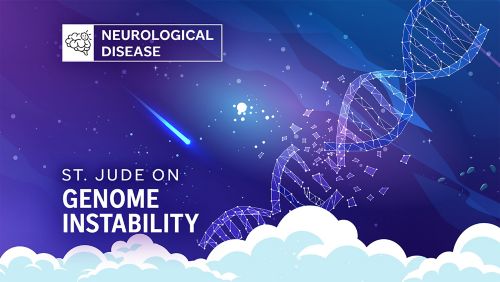St. Jude Family of Websites
Explore our cutting edge research, world-class patient care, career opportunities and more.
St. Jude Children's Research Hospital Home

- Fundraising
St. Jude Family of Websites
Explore our cutting edge research, world-class patient care, career opportunities and more.
St. Jude Children's Research Hospital Home

- Fundraising
Genomic instability is a risk for neurological disease and an opportunity for intervention

Artistic rendering of an unstable genome. Graphic by Briana Williams.
Buying a car is a rite of passage, the realization of the dream of freedom to travel to new places. Without an engine, however, a car isn’t going anywhere. Even the most minor flaw in an engine can erode its functionality over time, worsened by the chemical reaction between oxygen and fuel that releases the energy to power movement. Not performing regular maintenance can lead to disaster.
The brain is like the body’s engine; as the biggest oxygen user, undesirable chemical reactions can cause DNA damage. That damage can lead to neurological disease, especially because some neurons require lifetime maintenance. Due to this unique situation, faulty DNA repair and maintenance mechanisms are often more detrimental to the brain than the rest of the body.
Peter McKinnon, PhD, St. Jude Center for Pediatric Neurological Disease Research director and Department of Cell and Molecular Biology vice-chair, has spent most of his career seeking to understand how DNA damage response proteins connect to neurological diseases. “Many DNA repair factors are mutated in neurologic disease,” McKinnon explained. “Even though people have these mutations in every cell of the body, only the nervous system is affected for many of the syndromes associated with genome instability. This points to just how profoundly important maintaining your DNA is in the nervous system.”
Describing DNA repair breakdowns before building back up
Throughout his career, McKinnon wanted to find ways to help those with neurological and neurodegenerative diseases. He realized the only way to do so was to understand the normal processes these syndromes disrupt on a molecular level. With that information, researchers could create a diagram of how those repair mechanisms should function, similar to a mechanic making a diagram of an engine to help them understand what happens when things go wrong.
For example, while investigating an endonuclease that repairs damage from reactive oxygen species, McKinnon’s lab discovered how its loss affects genome instability and potentially leads to neurological disease, published in The Proceedings of the National Academy of Sciences.

Peter McKinnon, PhD, St. Jude Center for Pediatric Neurological Disease Research director and Department of Cell and Molecular Biology vice-chair.
“We found that APE1 disruption in neurons had a massive effect on brain development, but only after birth,” explained first author Lavinia Dumitrache, PhD, St. Jude Department of Cell and Molecular Biology. “When animals switched from embryonic to mitochondrial respiration, there was severe apoptosis and unrepaired DNA damage in many brain regions.”
The study showed that some broken genome repair mechanisms are only noticeable when oxygen becomes readily available to neurons. Once that happens, reactive oxygen species become more common in cells, leading to more DNA damage, accumulating without being repaired. That damage can then lead neurons toward self-destruction via apoptosis (cell death).
In addition to neuronal apoptosis, if the scientists deleted the tumor suppressor p53 in those without functional APE1, 100% of the mice developed some form of brain cancer. The exact cancer type varied, indicating that the loss of DNA repair in the presence of oxidative respiration was having global ramifications for DNA.
“The brain is very metabolically active, so there are a lot of oxidative byproducts that can attack structures in the cell, including DNA,” McKinnon said. “Efficient genome maintenance safeguards standard cellular processes, like transcription and translation. But we’ve shown that if those systems are dysfunctional, the immature brain, which is growing and metabolizing rapidly, is particularly sensitive.”
While understanding the basics of how DNA repair works is one goal, the lab also focuses on finding real-world neurological diseases with those processes disrupted and determining how to study them in the lab.
Making lab models of neuropathy to understand disease
“We looked at the unique protein PNKP because it is involved in various neurological diseases,” said Dumitrache, a co-author of an EMBO Journal study on the molecule. “Defects can lead to microcephaly and seizures in young children, but also moderate progressive diseases. If we understand what’s wrong in neurons and find the right treatment, we could really improve these patients’ lives.”
To understand how PNKP causes these diseases, the lab created a conditional knockout mouse that lacked the protein in neuronal and other brain cells. The model showed that PNKP’s absence resulted in neuropathy and neurodegeneration similar to those seen in humans. Findings from the study supported that PNKP has many varied effects because of its multiple DNA repair functions towards DNA breaks. The protein has a dual function: assisting in both single- and double-strand DNA breaks. It does this through kinase activity, adding phosphate groups to DNA to help seal its backbone, and phosphatase activity, where it removes phosphate groups. The lab is now attempting to better understand how PNKP alterations affect these different functions, leading to different diseases, and how to intervene.
“We generated a model that mimics aspects of the human diseases, so now we can develop and characterize the PNKP mutations and understand the disrupted mechanisms to hopefully design new potential therapies,” Dumitrache said.
Fixing the cell’s DNA repair systems to help patients
Given the profound impact these syndromes can have on the developing brain, McKinnon is dedicated to finding ways to apply his laboratory findings to help patients. This approach is a cornerstone of the Pediatric Translational Neuroscience Initiative, which seeks to translate scientific findings into clinical interventions. One example is childhood syndrome ataxia-telangiectasia (A-T), which McKinnon has been interested in since his early graduate work.
A-T involves flaws in the DNA double-stranded break repair protein ATM. Earlier work published in Science and Genes and Development by McKinnon’s lab showed ATM loss protected neural cells from DNA damage-induced cell death, leading to an accumulation of DNA damage and neurodegeneration over time. Since then, the St. Jude group has uncovered molecular features of the disease and its natural history (progression of disease over time without treatment) and now focuses on informing potential treatments.
“The mutations in this syndrome can be addressed by new therapeutic technologies, such as antisense oligonucleotides, with which we have clinical experience in PTNI,” McKinnon said. “Because of our research experience at St. Jude, we think we can understand how to molecularly correct ATM’s function.”
Other parts of the PTNI program have clinical experience evaluating neurologically based movement disorders and antisense oligonucleotide therapies. This creates a virtuous feedback cycle with the McKinnon labs’ fundamental work on genomic instability, hopefully leading to ever-improving treatments for neurological diseases. McKinnon is now working with his colleagues in PTNI to bring his learnings about A-T into the clinic, creating a template to follow for the related diseases caused by APE1, PNKP and other genome stability proteins’ mutations in the future.
“Through PTNI, we can share our deep experience to know what to expect and when to expect it during treatment so that we can effectively determine the milestones of the disease and how effective these therapies are,” McKinnon said. “Our fundamental understanding of the genomic instability and biological features underlying these diseases will couple with our collaborators’ clinical expertise in neurological disorders. Together, we will push forward better therapies for these patients, especially those with syndromes that currently have no effective interventions.”
Just like someone buying a car, these patients will have a new lease on life, with the freedom to pursue their dreams.






